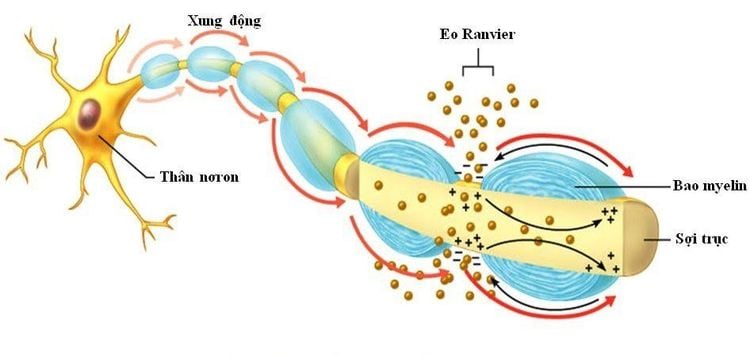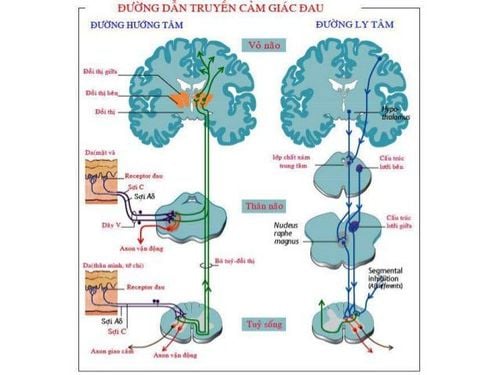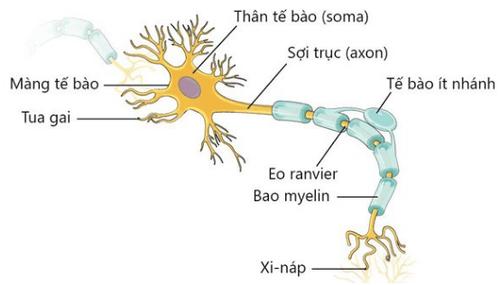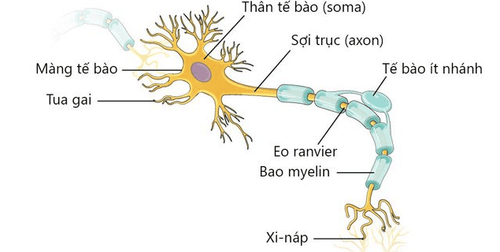This is an automatically translated article.
Sensory and motor transmission of nerves follow afferent and efferent pathways. Nerves are the source of the common pathway for the transmission of nerve impulses that are transmitted along the axon to the peripheral organs.1. Nerves
The neuron is the structural unit of the nervous system. Each neuron consists of a body containing the nucleus, ellipsoidal star or oval, and fibers. From the stem grow many short, branching twigs called dendrites and one long, thin tassel called the axon. There may be a myelin sheath along the axon. Axons connect the central nervous system with organs, they go together in bundles called nerves.The basic function of neurons is to induce and transmit nerve impulses in the form of chemical signals. Nerves provide a common pathway for nerve electrical impulses to be transmitted along axons to peripheral organs.
Nerves transmit nerve signals between different regions of the body. There are 3 types of nerves:
Sensory nerves (afferent nerves) carry sensations from anywhere to the nerve center. The motor (centrifugal) cord carries the response signal from the central nervous system or transmits the signal to other nerve regions. Phase wires: afferent fibers are usually paired with afferent fibers from motor neurons (central to peripheral) to form mixed, or biphasic, nerves that conduct signals in two-way.
Trắc nghiệm: Bài kiểm tra chỉ số trí tuệ cảm xúc (EQ) của bạn
Chỉ số trí tuệ cảm xúc Emotional Quotient (EQ) là một chỉ số dùng để nói lên trí tưởng tượng, đánh giá và cảm xúc của một con người. Hãy làm bài trắc nghiệm sau để biết chỉ số EQ của bạn là bao nhiêu?
Nguồn tham khảo: webmd.com
2. Conduction of nerve impulses on axons of neurons
Sensors are receptors responsible for detecting pain or other stimuli, they are nerve endings; It is widely distributed in the skin, joints, periosteum, around the walls of blood vessels and less in internal organs.
Sensory and motor transmission of nerves follow 2 pathways: afferent and efferent conduction.

2.1. Afferent pathways Transmit pain sensation from the periphery to the spinal cord
Sensory conduction from the periphery into the spinal cord is handled by the first neuron cell body located in the posterior dendritic ganglia. Afferent sensory nerve fibers are of different types and sizes:
Aα and Aβ fibers (types I and II) are large, myelinated, fast conduction fibers. , which mainly transmits somatic sensations (deep sensation, fine touch). Aδ (type III) and C fibers are small fibers and mainly conduct pain, heat, and gross touch. Aδ fibers are fast pain receptors, and C fibers are slow pain receptors. Aδ fibers are responsible for the sudden sensation of pain immediately followed by tissue damage (myelin speeds up conduction of nerve fibers) C fibers (have slower conduction time because of the absence of myelin sheath) responsible for slower conduction of pain continuum. C fibers continue to be stimulated and remain stimulated for some time after the stimulus is removed. Transduction of sensory information based on action potentials takes place in nerve fibers. Action potentials conduction in neurons are caused by the exchange of ions across the neuronal membrane.
Normally, the inside of the neuron has a negative charge compared to the outside, and the neuron membrane is in an unexcited state. Upon sensory stimulation, neurons are depolarized and become positively charged.
All of the above happens in milliseconds.
2.2. Efferent pathways Sensory information is formed in the colloidal rolando by descending pathways from the brain stem, pons, and midbrain.
Neurons in the brain stem will secrete serotonin, which inhibits the pain transmission neurons of the spinal cord, reducing or eliminating pain.
From the cerebral cortex, the efferent conduction pathway is activated and the signal passes through the efferent nerve pathway back to the peripheral receptor which helps to move the affected body parts away from the painful stimulus.
The efferent pathway includes the cerebral cortex, thalamus, and brain stem. Within the gray matter, the initial stimulation secretes neurotransmitter inhibitors such as endorphins, serotonin, 5-HT, and gamma aminobutyric acid (GABA) with opioid-like activity.

These endorphins bind to the receptor sites and help to modulate or reduce the activation of afferent neurotransmission at the synaptic cleft, thereby reducing the sensation of pain.
2.3. Visceral pain and the role of the sympathetic nervous system Different from pain in the skin with a clearly localized location, visceral pain is vague and dull, sometimes acute due to its spasmodic nature.
Painful stimuli in the body such as cutting, crushing, and squeezing, if they affect the internal organs, will not cause pain, but the factors of tension, anemia and inflammation will cause pain.
Visceral pain is innervated by the Aδ and C fibers. These fibers, together with afferent autonomic nerve fibers, enter the medulla in the thoracic, dorsal, and sacral segments, and then separate from fibers that ascend above and below the medulla, penetrate deeply into layers I and V, and then ascend to the brainstem in the middle. Nerves that transmit pain information in the body. Therefore, visceral pain often manifests as radiating pain and is associated with disorders of the autonomic nervous system.
In addition to visceral pain, pain due to trauma in the extremities also has sympathetic factors, causing vasomotor dysregulation, sweating, skin temperature changes, confusion. skin nutritional disorders, reduced mobility... making the pain worse.
Sympathetic neurons that release adrenaline can affect the nerve fibers that transmit pain by the action of noradrenalin to the nerve apex, along the axon or posterior roots. One of the neural responses to injury is an increased activity of alpha adrenaline-releasing receptors (i.e. alpha receptors) in pain neurons.
3. Velocity measurement of motor and sensory conduction - Electromechanical recording method
3.1. Electromyography Electromyography and nerve conduction studies are exploratory methods used to study the electrical responses of nerves and muscles, and to assess the loss of nerve distribution. of muscle.
This method helps to evaluate the function of nerves, peripheral nerve roots, synapses and muscles.
They are very important adjunctive techniques for definite diagnosis, differential diagnosis of lesion nature (motor neurons, myelin, axons or associated lesions), local diagnosis and prognosis. disease, thereby helping clinicians to identify the cause of the disease and treat it effectively.
3.2. Measure the speed of motor nerve conduction The surface electrode is placed at the site of the muscle mass that is innervated by the probing nerve (medial, ulnar, and bilateral medial and lateral popliteal).

Stimulation: 0.5 - 1 millisecond square pulses stimulate points along the nerve path.
Calculate the conduction rate:
If L1 is called the latent time (from the moment of stimulation to the appearance of the muscle contraction response at the nerve apex), let L2 be the latent time when stimulating the root nerves (in milliseconds - ms). D is the distance between two excitation points (mm), nerve conduction speed (V) (meters/second – m/s) between two stimulus points will be calculated by the formula: V (m/s) = D (mm) / [ L2 (ms) - L1(ms) ]
Amplitude is calculated from the lowest point to the highest point of the sensory potential, in milliVolt (ms).
3.2. Sensory nerve conduction velocity measurement

Stimulation: 0.5 - 1ms square pulses stimulate at a point along the path of peripheral sensory nerves (bilateral median, ulnar, and saphenous nerves).
Record: The surface electrode records the response on the path of the nerve to be probed. The sensory latency period is the sensory conduction time of the nerve itself (because there are no synapses separating the receptors and the sensory fibers).
Calculation of nerve conduction rate: Let the sensory potential time be t (in seconds –s), the distance from the recording electrode to the stimulation electrode is d (in mm), the sensory conduction rate sense v is calculated by the formula:
v = d/t
- Amplitude is calculated from the lowest point to the highest point of the sensory potential, in microVolt (μV):
Determine the result:
Decrease Conduction rates and latency prolongation reflect myelin damage. Decrease in amplitude of responses indicative of axonal injury. At Vinmec International General Hospital, the method of recording electromyography and nerve conduction velocity is used in the diagnosis of nerve and muscle abnormalities. This technique is performed by a team of Vinmec doctors and nurses who are well-trained, professional and experienced; with the support of modern and advanced equipment; professional medical service quality.
Please dial HOTLINE for more information or register for an appointment HERE. Download MyVinmec app to make appointments faster and to manage your bookings easily.
Articles refer to the source: Vietnam Neurological Association













